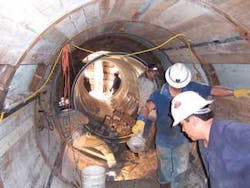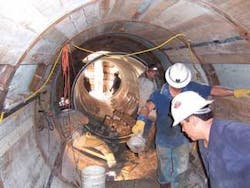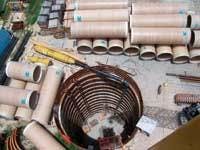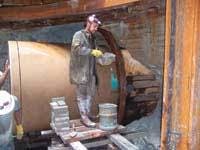Tunneling Used to Minimize Disruption During Pipeline Projects
A long buried problem in Austin, TX, was finally solved with tunneling and boring used to install new pipe with minimal disturbance to the surface.
For more than 15 years, residents in the neighborhood had complained about wastewater discharges from the Little Walnut Creek interceptor. Infiltration and inflow were the problem with the 42-inch pipeline that runs beneath a stream and has manholes rising out of the water every 100 yards. When it rained, the sanitary sewer would overflow into the creek.
During the late 1980s, the city originally proposed to replace the interceptor, but residents blocked the project over concern that the proposed open cut construction would disrupt nearby neighborhoods and cause environmental harm to the creek. Unhappy residents also blocked a redesigned project.
But all that changed when the Environmental Protection Agency’s Region 6 presented the Austin Water Utility with an Administrative Order requiring the central Texas utility to eliminate sanitary sewer overflows by December 2007 to protect its water supply. Austin is located in the Highland Lakes area of Texas and has a number of water features including Barton Creek and the Barton Springs Edwards Aquifer, a sole-source drinking water aquifer and one of the most prolific artesian aquifers in the world.
Little Walnut Creek
Austin faced a tight schedule and had to work very quickly. The tasks included land acquisition, permitting, design and construction of numerous projects for its five-plant, 2,316-mile collection system. The Little Walnut Creek Tunnel Interceptor Project One was the most challenging and critical. City officials wanted to use a fiberglass pipe system with a proven track record and a leak-free joint system. They conducted an extensive evaluation and eliminated all other fiberglass pipe products except Hobas centrifugally cast, fiberglass reinforced, polymer mortar (CCFRPM) pipe.
Under Austin’s Clean Water Program (CWP), this third and final design was assigned to national engineering and consulting firm Brown and Caldwell (BC), one of several engineering firms involved in the many mandated projects.
Combining engineering with community relations, BC’s design used Tunnel Boring Machine (TBM) technology to construct a new 10,000-foot, 96-inch-diameter primary tunnel in one continuous run with no intermediate shafts. The $12.7 million project design called for a 60-inch fiberglass carrier pipe that was specified in order to increase the pipeline’s useful life compared with other materials.
Hobas CCFRPM pipe selected for the project had a 72-psi pipe stiffness rating and flush bell-spigot couplings. To expedite the project, two insertion shafts were used. The first pipe placed was at the midsection of the tunnel and was a special bell-by-bell CCFRPM pipe. Subsequent CCFRPM pipes were carried into the tunnel from two insertion points, one at each end. Pipes were brought in with the bell trailing and blocked in place. Blocking was straightforward and rapid due to the flush exterior of the coupling. The simple push-together assembly of the couplings sped insertion.
Long life was of primary importance to the City of Austin. The Hobas pipe’s inherent corrosion and abrasion resistance contribute to its time longevity. The city was especially impressed with the quality control at the company’s manufacturing facility in nearby Houston. Representatives completed an extensive and very thorough audit of the system from raw material through finished product and testing. This resulted in an approval by the City of Austin’s Standard Products List without any reservations.
Installation was assigned to KM&M JV of Solon, OH.
“There are things that Hobas pipe do can for a contractor in a tunnel that other pipes can’t do,” said Lee DuPont, project manager. “I’m pretty partial to it because it is very easy to install compared to concrete pipe due to weight. Steel pipe is a pain in tunnels because of the working conditions, having to weld joints and so forth.”
The mining crews worked 140 feet below the surface in the Austin hill country during the hot Texas summer, pushing a TBM along the pipeline route. The choice of CCFRPM pipe increased their efficiency. Because of the pipe’s high strength, it has a much thinner wall than many competing products. This was of great benefit on the Little Walnut project, since it was a perfect fit to the available pipe carrier, and provided extra room for alterations in pipe alignment within the primary tunnel, which was constructed of steel ring beam and wooden lag.
“Our initial bore was right at 99 inches, that’s the machine we had available. The ribs were about four inches, so the primary tunnel provided plenty of working space for the 60-inch liner. Our TBM was 31 feet long. With a trailing sled to accommodate the conveyor and muck (spoil-removal) cars, this totaled 90 to 100 feet. We were placing the primary support right behind the cutting head. We encountered all solid rock the whole way; the conditions were pretty consistent,” DuPont said.
Some of the tunnel was located within right-of-way of existing streets. Crispin Ruiz, who handles public information for the Austin CWP, said, “The public appreciated the fact that it was a tunnel and didn’t disrupt the neighborhood. The residents were also concerned about any disruption to the sensitive environment around Little Walnut Creek. So, from the neighborhood’s perspective, it’s been a very successful project just because it didn’t disrupt their day-to-day lives.”
Shoal Creek
Another Austin CWP installation was part of the overall plan. The Shoal Creek Tunnel Project reached its first objective with the finishing of the Mainline Tunnel excavation. The tunnel lining is a 66-inch CCFRPM pipe, with 72 stiffness and FWC couplings. It was used to replace the 54-inch reinforced concrete pipe (RCP) wastewater line that was exposed within the banks of Shoal Creek. The creek was vulnerable to flooding and the existing line had a potential breech, so the project was included in the Austin CWP and installed by W.L. Hailey of Nashville, TN.
The 3,200-linear-foot run was completed after the crew negotiated two tight radius curves of 400 feet and 600 feet that made up about half of the drive. They also had to reconfigure the cutter head in place, with 500 feet remaining in the drive, because of a change in geology from 500 psi clay to 10,000 psi limestone.
The Crosstown Shaft was excavated at the same time the 66-inch Hobas pipe was being installed. The main part of the job was completed when the mainline tunnel was connected to the Crosstown Shaft, which carried flow to the existing Crosstown Tunnel. Other elements of the project included junction boxes, directionally drilled lateral connections, several short open-cut runs and the rehabilitation of several existing lines and manholes.
Barton Creek
One other project of interest was dubbed the Barton Creek Lift Station Relief Tunnel, which was awarded to Dibco Underground of Ontario, Canada. It began when the contractor set up the work area in Zilker Park, just north of Barton Springs Road. The project was planned to avoid disrupting activities in the park and on nearby Toomey Road.
It provides a 33-inch diameter CCFRPM pipe installed in two sections of a tunnel. A shallow tunnel in Zilker Park is about 1,700 feet long, and the 33-inch pipe extends into the existing interceptor with the annular space filled with grout.
A drop shaft joins this shallow tunnel to a deeper tunnel that extends for 1,600 feet under Barton Creek to the shaft site off Toomey Road. The main shaft at Toomey is about 70 feet deep, and has a temporary lift station built within the shaft to lift the wastewater to the adjacent South Austin Outfall. The temporary lift station will be underground, and will be operated until mid-2010 when it will be taken offline by a deeper tunnel system.
Conclusion
“Hobas was chosen for these projects for a multitude of reasons,” said Stan Evans, project manager, Austin CWP. “The most important one is that the Austin Water Utility established a policy long ago to have all new pipe that they install, at least large diameter pipe, to be a fiberglass type pipe so that they wouldn’t have to deal with the constant problem of corrosion. That is something they are experiencing now with concrete pipe and the maintenance effort that it generates, especially when it comes to having to reline those pipes - or as we are in the process of doing for some of them - having to replace them.
“And another factor is the tightness of the joint that the Hobas pipe provides. That’s obviously a wonderful thing compared to the long-term outlook for the old joint installations with RCP that over decades are eventually going to allow leakage. And that means two things: we’re either releasing wastewater to the environment or we’re taking in ground water, which we do not want to have to do because that increases the flow in our lines, can cause overflows and create quite a bit of additional load to treat at our plant. During an unusually rainy event, it can actually overwhelm our plants.”



